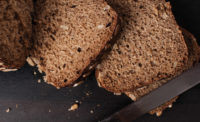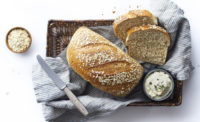Leavening is a fundamental ingredient category in baking that performs some serious heavy lifting. Leavening agents help create the textural quality in many baked goods. There are three main classifications of leavening agents: biological, chemical, and physical. Some of the trends seen with leavening agents include a move toward cleaner label and non-GMO.
Clean and efficient
Pak Group, Pasadena, CA, recently worked closely with its industrial bakery customers to develop a new product, Bellarise Supreme Instant Dry Yeast. This new variant can shorten proof times by up to 15 percent, increases volume and oven spring, and yields up to 30 percent more gassing power when compared to other leading instant dry yeasts, notes Cam Suarez-Bitar, marketing and public relations manager.
“What also makes Bellarise Supreme Instant Dry Yeast special is that it is easy to use in industrial bakeries and helps reduce costs,” says Suarez-Bitar. “It is perfect for commercial and industrial bakeries that bake breads with 6 percent or less sugar. From sourdoughs and baguettes to pan breads and pizza crusts, bakeries can bake their favorite breads exactly how they want while seeing savings either in bake time and processing or overall production costs.” This new ingredient has a two-year ambient shelf life, which helps ensure consistent performance and easy storage.
“Part of what makes Bellarise Instant Dry Yeast special is the fact that it’s raised on simple, non-GMO beet molasses, not high-fructose corn syrup,” says Suarez-Bitar. The product can be used in a wide variety of breads, including sourdoughs, bagels, ciabatta, and English muffins.
Lesaffre, Milwaukee, WI, cites forecast data from Market Research Future that the organic bakery market is projected to grow at a CAGR of 6.5 percent from 2019 to 2024, reaching $13 billion. The company is seizing this opportunity and recently launched Red Star Organic Yeast.
“Red Star Organic Yeast is the only commercially available organic yeast made in the U.S.,” says Bill Hanes, VP marketing and strategy, Lesaffre. “Non-organic yeast may face a sunset ruling by the National Organic Standards Board in 2021, so bakers who want to maintain or earn organic certification will need organic yeast.” Another benefit, since the product is manufactured in the U.S., is that manufacturers can rely on a consistent supply chain and sustainable production.
Sourdough soaring
Sourdough was already trending, but the recent pandemic has fast tracked interest in sourdough. Data shared by Lesaffre states that the global sourdough market is expected to grow at a CAGR of 7.2 percent between 2020 and 2025, according to Mordor Intelligence. “This market is being driven by a growing demand for healthier or gluten-free options, as well as increased interest in fermented products. The fermentation process naturally provides a clean label and contributes health benefits to sourdough bread,” explains Hanes.
Hanes notes that as the preference for the unique flavor of sourdough continues to grow, the applications using sourdough have expanded. Sourdough desserts such as cakes and pies with sourdough crusts are gaining traction, along with sourdough doughnuts, croissants, brioche, and panettone. Lesaffre offers Livendo sourdough solutions that are incorporated directly into flour and result in easier-to-shape dough and greater efficiency in production. These products work for fresh, par-baked, and frozen doughs.
Puratos, Pennsauken, NJ, has continued to innovate its sourdough solutions. “This new level of exposure to sourdough starters has shown U.S. consumers that sourdoughs do not necessarily need to be super sour, and a unique sourdough starter can create a world of flavor and textures. In addition to this, U.S. consumers are now more aware of the health halo surrounding natural fermentation and the impacts it can have on digestibility. All of these things have created an opportunity to market and position sourdough products like never before. We see a rise in popularity in a number of sourdough finished goods outside of bread products, such as crackers, pretzels, croissants, and doughnuts,” explains Michael Gleason, product manager, sourdough and grains, Puratos USA.
Brian Chang, R&D manager, sourdough and grains, Puratos USA, describes the range of product offerings: “Our product range is oriented to natural fermentation products to deliver on the taste, texture, and flavor of sourdough without lengthy fermentation processes and without the need to continuously refresh an in-house sourdough starter. The biggest impact our products have on quality and consistency is in terms of taste and flavor complexity. The key benefit we are providing is a sourdough that delivers the same flavor day in and day out without the need to add complex fermentation processes to existing production lines.” These sourdough products are pre-fermented, shelf stable, and ready to use, and are best suited for both packaged and unpackaged artisan-style breads.
Cleaner labels
Bartek, Stoney Creek, Ontario, understands the need for continuous improvement and innovation and recently introduced two new, unique, proprietary ingredient systems: Upscale and Uphold. “Upscale is a patent-pending technology designed to deliver high-quality artisan breads produced at an industrial scale,” says Mohammad Emami, senior product manager. “Uphold improves the quality of traditional breads (i.e., pan bread) and rolls, and allows for precise control of mold-free shelf life in a cost-effective manner.” The new specialty systems based on fumaric acid provide softness, increased volume, and improved cell structure development.
“Upscale is designed to make the scale-up of artisan breads at an industrial scale more practical by achieving key product attributes more consistently, namely porosity and volume,” says Alejandro J. Perez-Gonzalez, lead technical advisor, bakery innovation, Bartek. “This is very important with transitioning these products from old-style, hand-crafted operations that utilize only minimal ingredients, to more-efficient production settings that require more-robust formulas. Uphold is designed to achieve a more-predictable and consistent mold-free shelf life in breads that already use preservative like calcium propionate. Uphold makes the use of calcium propionate more efficient, taking advantage of the unique properties of fumaric acid to control pH, all in an easy-to-use, carefully formulated and complete preservative system. Additionally, Uphold helps to achieve better volume and product softness, improving overall product quality and consistency.”
Caldic, Mississauga, Ontario, has introduced Promase Clean Plus, a new clean-label system that provides dough with elasticity, tolerance, improved volume, and a softer crumb, while also delivering enhanced crusty and yeasty notes. “Promase Clean Plus will provide not just consistency in flavor profile of the bread, but will also help in giving dough strength and tolerance making it more robust during processing,” says Lariza Lopez de Leon, senior product technologist, bakery. “This equates to consistent volume and texture. This new system is especially designed for yeast-raised applications where flavor and texture of a traditional sponge and dough process can be achieved at reduced processing time. Promase Clean Plus eliminates the sponge step (pre-ferment) in a sponge and dough process, which could take 3.5–5 hours of fermentation time while delivering the flavor and texture from using a pre-ferment. This new product has been formulated for bread, buns, rolls, and flatbreads such as pizza crust.”
Caldic also offers several different leavening systems under its Lift & Lite brand. These chemical leaveners are designed to provide gas release at the appropriate time depending upon the application and process and are available in conventional, low-sodium, gluten-fee, non-GMO, and organic options. These products are best suited for cake and other sweet goods applications.
AB Mauri North America, St. Louis, will soon launch a new Non-GMO Project Verified, organic-compliant, and gluten-free double-acting baking powder. “The sourced ingredients were evaluated for dough rate of reactions (DRR) and test baked to ensure an optimized gassing reaction for bakery applications,” says Paul Bright, senior innovation manager. “The aluminum-free, double-acting baking powder is designed to provide initial carbon dioxide release during the mixing stage to help generate cell nucleation, with most of the leavening occurring during the baking stage. This is done to ensure optimal baked height with fine, uniform cell crumb structure for cakes, as well as the production of opaque, fluffy tortillas. The aluminum-free, double-acting baking powder has a regulated gassing rate to provide the baker with increased tolerance to any production issues. This will allow for the manufacture of consistent end product characteristics.” This new ingredient can be used in a wide range of applications, including cakes, biscuits, and tortillas, and will be available in the first quarter of 2021.






